Reptilien 03: analyse Von daten
正则表达式

一、正则表达式的简介
1、 概念
- 正则表达式是对字符串操作的一种逻辑公式,就是用事先定义好的一些特定字符、特定字符的组个,自称一个“规则字符串”,这个“规则字符串”用来表达对字符串的一种逻辑过滤。
2、正则表达式的应用场景
- 表单验证(如:手机号、邮箱、身份证…)
- 爬虫
二、正则表达式对python的支持
1、普通字符
- 字母、数字、汉字、下划线、以及没有特殊定义的符号,都是"普通字符"。正则表达式中的普通字符,在匹配的时候,只匹配与自身相同的一个字符。
- 例如:表达式c,在匹配字符串abcde时,匹配结果是:成功;匹配到的内容是c;匹配到的位置开始于2,结束于3。(注:下标从0开始还是从1开始,因当前编程语言的不同而可能不同)
2、match()函数
- 语法:
match(pattern, string, flags=0) - 第一个参数是正则表达式,如果匹配成功,则返回一个match对象,否则返回一个None。
- 第二个参数表示要匹配的字符串。
- 第三个参数是标致位用于控制正则表达式的匹配方式 如: 是否区分大小写,多行匹配等等。
扩展:标识位
| 修饰符 | 描述 |
|---|---|
| re.I | 忽略大小写 ( IGNORE CASE ) |
| re.L | 做本地化识别(locale-aware)匹配 ( LOCALE ) |
| re.M | 多行模式(MULTILINE ) |
| re.S | 使’.'特殊字符匹配任何字符,包括换行 ;如果没有此标志, '.'将匹配任何内容除换行符。( DOTALL ) |
| re.U | 根据Unicode字符集解析字符。这个标志影响 \w, \W, \b, \B. ( UNICODE ) |
| re.X | 标志通过给予你更灵活的格式以便你将正则表达式写得更易于理解 ( VERBOSE ) |
代码演示:
import re
'''
pattern--->正则表达式:如果匹配成功,则返回一个match对象,否则返回一个None
string--->需要匹配的数据
flags=0--->标致位:控制正则表达式的匹配方式(是否需要换行匹配,是否区分大小写......)
# match函数只能从开头匹配,不能从其他位置匹配
'''
# re.match(pattern, string, flags=0)
s = 'python and java'
pattern = 'python' # 正则表达式
result = re.match(pattern, s)
if result:
# print(result) # 返沪:<re.Match object; span=(0, 6), match='python'>
print(result.group()) # 返沪:python
else:
print('没有匹配!')
3、元字符
- 正则表达式中使用了很多元字符,用来表示一些特殊的含义或功能。
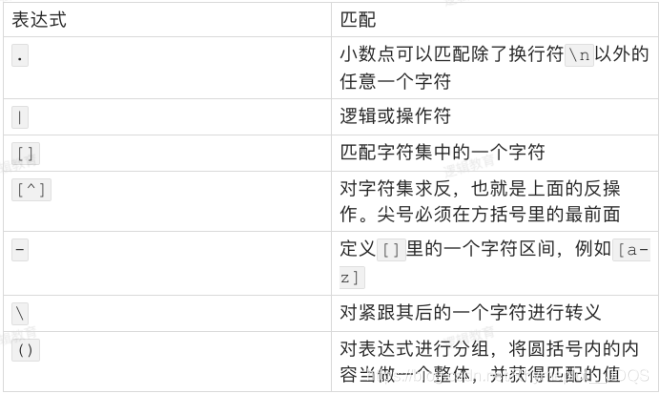
- 一些无法书写或者具有特殊功能的字符,采用在前面加斜杠” / “的方法。
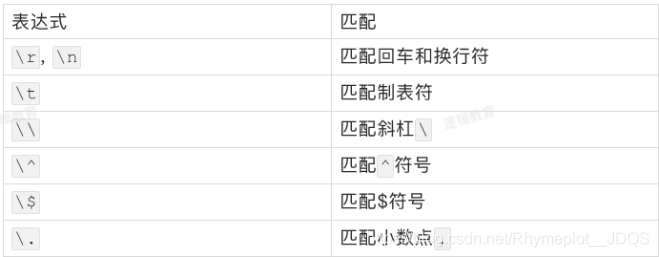
- 尚未列出的还有问号” ? “、星号” * “和括号”()“等其他的符号。所有正则表达式中具有特殊含义的字符在匹配自身的时候,都要使用斜杠进行转义。这些转义字符的匹配用法与普通字符类似,也是匹配与之相同的一个字符。
4、预定义匹配字符集
- 正则表达式中的一些表示方法,可以同时匹配某个预定义字符集中的任意一个字符。比如,表达式\d可以匹配任意一个数字。虽然可以匹配其中任意字符,但是只能是一个,而不是多个
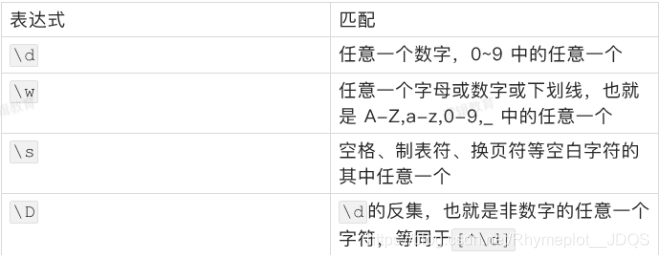
代码演示:
import re
'''
01:\d--表示匹配0-9当中的任意一个字符
'''
result1 = re.match(r'\d', '123').group()
print(result1)
'''
02:\w--表示匹配任意一个字母或数字或下划线,即0-9、a-z、A-Z
'''
result2 = re.match(r'\w', '123').group()
print(result2)
result3 = re.match(r'\w', 'a123').group()
print(result3)
result4 = re.match(r'\w', 'A123').group()
print(result4)
'''
03:\s--表示匹配空格、制表符、其他的一些空白
'''
result5 = re.match(r'\s', ' ').group()
print(result5)
'''
04:\D(\d的反集--表示非数字当中的任意一个
'''
result6 = re.match(r'速度与激情\D', '速度与激情a').group()
print(result6)
'''
05:\W(\w的反集)--表示匹配一些特殊符号
'''
result7 = re.match(r'\W', '&^%%').group()
print(result7)
'''
06:\S(\s的反集)--表示匹配除了空格、制表符、其他的一些空白的任意字符
'''
result8 = re.match(r'\S', 'sdsdfasd').group()
print(result8)
result9 = re.match(r'\S', '158532').group()
print(result9)
5、重复匹配
- 前面的表达式,无论是只能匹配一种字符的表达式,还是可以匹配多种字符其中任意一个的表达式,都只能匹配一次。但是有时候我们需要对某个字段进行重复匹配,例如手机号码13666666666,一般的新手可能会写成\d\d\d\d\d\d\d\d\d\d\d(注意,这不是一个恰当的表达式),不但写着费劲,看着也累,还不⼀定准确恰当。
- 这种情况可以使用表达式再加上修饰匹配次数的特殊符号{},不但重复书写表达式就可以重复匹配。例如[abcd][abcd]可以写成[abcd]{2}
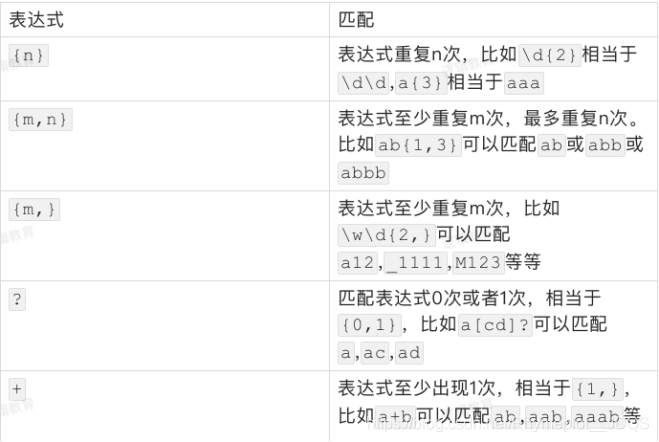
import re
'''
# {n}:表达式重复n次。
'''
# 代码演示
result1 = re.match(r'\d{3}', '123').group()
print(result1)
result2 = re.match(r'^1[345678]\d{9}$', '15840039263').group()
print(result2)
'''
# {m,n}:表达式至少重复m次,最多重复n次。
'''
# 代码演示
result3 = re.match(r'\d{3,4}-\d{7,8}', '0123-1234567').group()
print(result3)
'''
# {m,}:表达式至少重复m次。
'''
# 代码演示
result4 = re.match(r'\d{3,}-\d{7,8}', '012-1234567').group()
print(result4)
'''
# ?:匹配表达式0次或者1次
'''
# 代码演示
result9 = re.match(r'w[a-z]?', 'wa').group()
print(result9)
result10 = re.match(r'w[a-z]?', 'wae').group()
print(result10)
'''
# +:表达式匹配至少出现1次
'''
# 代码演示
result7 = re.match(r'w[a-z]+', 'weasd').group()
print(result7)
# result8 = re.match(r'w[a-z]+', 'w').group()
# print(result8) # 报错
'''
# *:表达式出现0次到任意次,相当于{0,}
'''
# 代码演示
result5 = re.match(r'w[a-z]*', 'wfadasd').group()
print(result5)
result6 = re.match(r'w[a-z]*', 'w').group()
print(result6)
6、位置匹配与非贪婪模式
①、位置匹配
- 有时候,我们对匹配出现的位置有要求,比如开头、结尾、单词之间等等
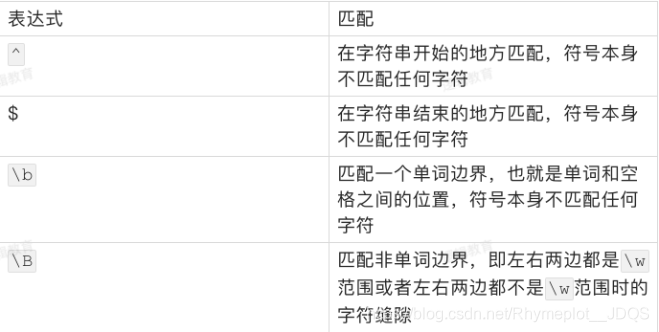
②、贪婪与非贪婪模式
- 在重复匹配时,正则表达式默认总是尽可能多的匹配,这被称为贪婪模式。例如,针对文本dxxxdxxxd,表达式(d)(\w+)(d)中的\w+将匹配第一个d和最后一个d之间的所有字符xxxdxxx。可见,\w+在匹配的时候,总是尽可能多的匹配符合它规则的字符。同理,带有?、*和{m,n}的重复匹配表达式都是尽可能地多匹配。
- 校验数字的相关表达式:
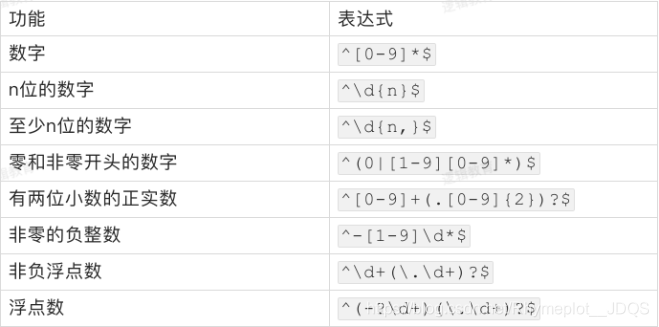
- 特使场景的表达式:
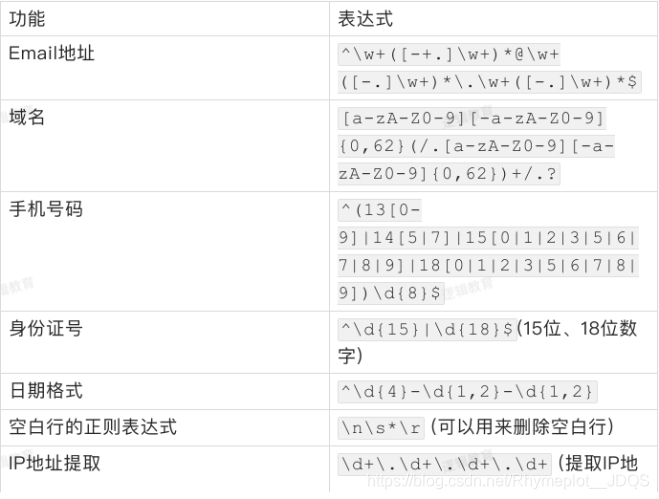
代码演示01:贪婪与非贪婪模式
import re
'''
# 贪婪匹配:以最长的结果做为返回,在python当中是默认贪婪的,总是尝试去匹配尽可能多的字符
'''
s = '<div>abc</div><div>bcd</div>'
# '''
# 需求:<div>abc</div>
# '''
ptn = '<div>.*</div>'
r = re.match(ptn, s)
print(r.group()) # <div>abc</div><div>bcd</div>
'''
# 非贪婪模式:总是尝试去匹配尽可能少的字符
# 怎么使用非贪婪模式:在.*加上?,在.+加上?或者{m, n}
'''
s = '<div>abc</div><div>bcd</div>'
'''
需求:<div>abc</div>
'''
ptn = '<div>.*?</div>'
r = re.match(ptn, s)
print(r.group())
打印输出结果:
C:\python\python.exe D:/PycharmProjects/Python大神班/day-06/01-非贪婪匹配.py
<div>abc</div><div>bcd</div>
<div>abc</div>
Process finished with exit code 0
代码演示02:正则表达式练习
import re
def fn(ptn, list):
for x in list:
result = re.match(ptn, x)
if result:
print('匹配成功!', '匹配结果是:', result.group())
else:
print(x, '匹配失败!')
# . :表示匹配除了换行符的任意字符
list = ['abc1', 'ab', 'aba', 'abbcd', 'other', 'another']
ptn = 'ab.'
fn(ptn, list)
# [] : 匹配中括号中列举的字符
list = ['man', 'mbn', 'mcn', 'mdn', 'mon', 'nba']
ptn = 'm[abcd]n'
fn(ptn, list)
# \d :匹配数字【0-9】
list = ['py9', 'py3', 'other', 'pyxx']
ptn = 'py\d'
fn(ptn, list)
# \D :匹配非数字的字符
list = ['py9', 'py3', 'other', 'pyxx']
ptn = 'py\D'
fn(ptn, list)
# \s :匹配空白字符
list= ['hello world', 'helloxxx', 'hello,world']
ptn = 'hello\sworld'
fn(ptn, list)
# \w :匹配单词、字母、下划线
list = ['1-age', 'a-age', '#-age', '_-age']
ptn = '\w-age'
fn(ptn, list)
# * :表示匹配出现0次或任意次
list = ['hello', 'abc', 'xxx', 'h']
ptn = 'h[a-z]*'
fn(ptn, list)
# {m} :表示匹配至少m次
list = ['hello', 'python', '^%%&%^#^$%', '123456']
ptn = '\w{6}'
fn(ptn, list)
# {m, n} :表示至少匹配m次,最多匹配n次
list = {'abcd', 'python', '*&%%*&*&', '_xxx211', '65465465'}
ptn = '\w{3, 5}'
fn(ptn, list)
# $ : 表示匹配带该字符(¥)结束
list = ['123@qq.com', 'abc@yy.com', 'bcd@qq.com.cm']
ptn = '\w+@qq.com$'
fn(ptn, list)
打印输出结果:
C:\python\python.exe D:/PycharmProjects/Python大神班/day-06/02-正则表达式练习.py
匹配成功! 匹配结果是: abc
ab 匹配失败!
匹配成功! 匹配结果是: aba
匹配成功! 匹配结果是: abb
other 匹配失败!
another 匹配失败!
匹配成功! 匹配结果是: man
匹配成功! 匹配结果是: mbn
匹配成功! 匹配结果是: mcn
匹配成功! 匹配结果是: mdn
mon 匹配失败!
nba 匹配失败!
匹配成功! 匹配结果是: py9
匹配成功! 匹配结果是: py3
other 匹配失败!
pyxx 匹配失败!
py9 匹配失败!
py3 匹配失败!
other 匹配失败!
匹配成功! 匹配结果是: pyx
匹配成功! 匹配结果是: hello world
helloxxx 匹配失败!
hello,world 匹配失败!
匹配成功! 匹配结果是: 1-age
匹配成功! 匹配结果是: a-age
#-age 匹配失败!
匹配成功! 匹配结果是: _-age
匹配成功! 匹配结果是: hello
abc 匹配失败!
xxx 匹配失败!
匹配成功! 匹配结果是: h
hello 匹配失败!
匹配成功! 匹配结果是: python
^%%&%^#^$% 匹配失败!
匹配成功! 匹配结果是: 123456
python 匹配失败!
abcd 匹配失败!
*&%%*&*& 匹配失败!
_xxx211 匹配失败!
65465465 匹配失败!
匹配成功! 匹配结果是: 123@qq.com
abc@yy.com 匹配失败!
bcd@qq.com.cm 匹配失败!
Process finished with exit code 0
三、re模块的常用方法
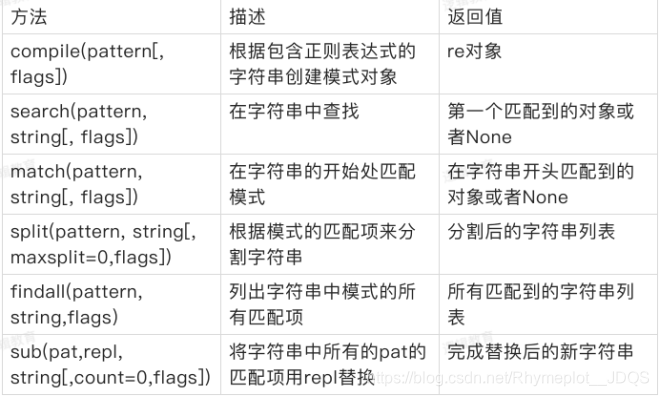
- compile(pattern, flags=0)
这个⽅法是re模块的工厂法,⽤于将字符串形式的正则表达式编译为Pattern模式对象,可以实现更加效率的匹配。第二个参数flag是匹配模式 使用compile()完成一次转换后,再次使用该匹配模式的时候就不能进行转换了。经过compile()转换的正则表达式对象也能使用普通的re⽅法
1、flag匹配模式

2、search(pattern, string, flags=0)函数
- 在文本内查找,返回第一个匹配到的字符串。它的返回值类型和使用方法与match()是一样的,唯一的区别就是查找的位置不用固定在文本的开头
3、findall(pattern, string, flags=0)函数
- 作为re模块的三大搜索函数之一,findall()和match()、search()的不同之处在于,前两者都是单值匹配,找到一个就忽略后面,直接返回不再查找了。而findall是全文查找,它的返回值是一个匹配到的字符串的列表。这个列表没有group()方法,没有start、end、span,更不是一个匹配对象,仅仅是个列表!如果一项都没有匹配到那么返回一个空列表。
4、split(pattern, string, maxsplit=0, flags=0)函数
- re模块的split()方法和字符串的split()方法很相似,都是利用特定的字符去分割字符串。但是re模块的split()可以使用正则表达式,因此更灵活,更强大。
5、sub(pattern, repl, string, count=0, flags=0)函数
- sub()方法类似字符串的replace()方法,用指定的内容替换匹配到的字符,可以指定替换次数
代码演示:
import re
# compile()--根据包含的正则表达式的字符串创建模式对象,返回正则表达式对象(re对象)
pat = re.compile(r'abc')
res = pat.match('abc123').group()
print(res)
# re.I-->表示不区分大小写匹配
pat = re.compile(r'abc', re.I)
res = pat.match('ABC123').group()
print(res)
# search()--在字符串中查找,返回第一个匹配的对象或者None
r = re.search(r'abc', '123abc456abc789').group()
print(r)
# findall()--作为re模块三大搜索函数之一,findall()与match()、search()的不同指出在于,前两者都是单值匹配,找到一个就忽略后边,而findall()是全文查找,它的返回值是一个匹配到的字符串的列表。这个列表没有group()方法,没有start、end、span,更不是一个匹配对象,仅仅是个列表!如果一项都没有匹配到那么返回一个空列表
r = re.findall(r'abc', '123abc456abc789')
print(r)
# split()--re模块的split()方法和字符串的split()方法很相似,都是利用特定的字符去分割字符串。但是re模块的split()可以使用正则表达式,因此更灵活,更强大
# split有个参数maxsplit(),用于指定分割的次数
s = '8+7*5+6/3'
r = re.findall(r'\d', s)
print(r)
r = re.split(r'[\+\*\/]', s)
print(r)
# maxsplit--最大分割次数
r = re.split(r'[\+\*\/]', s, maxsplit=3)
print(r)
# sub()--sub()方法类似字符串的replace()方法,用指定的内容替换匹配到的字符,可以指定替换次数
s = 'i am wangjiaxin i am very handsome'
r = re.sub(r'i', 'I', s)
print(r)
打印输出结果:
C:\python\python.exe D:/PycharmProjects/Python大神班/day-06/03-re模块常用的方法.py
abc
ABC
abc
['abc', 'abc']
['8', '7', '5', '6', '3']
['8', '7', '5', '6', '3']
['8', '7', '5', '6/3']
I am wangjIaxIn I am very handsome
Process finished with exit code 0
四、分组功能
- Python的re模块有一个分组功能。所谓的分组就是去已经匹配到的内容再筛选出需要的内容,相当于二次过滤。实现分组靠圆括号(),而获取分组的内容靠的是group()、groups(),其实前面我们已经展示过。re模块里的积个重要方法在分组上,有不同的表现形式,需要区别对待。
代码演示:反正组功能
# 分组,就是去已经匹配到的内容里面筛选出需要的内容(二次过滤)
import re
s = 'apple price is $66, banana price is $6'
'''
需求
$66
$6
'''
result = re.search('.+\$\d+.+\$\d+', s).group()
print(result)
result1 = re.search('.+(\$\d+).+(\$\d+)', s)
result2 = re.search('.+(\$\d+).+(\$\d+)', s)
print(result1.group(1))
print(result2.group(2))
print(result1.groups())
'''
print(result1.group(1))--匹配第一个分组
print(result2.group(2))--匹配第二个分组
print(result1.groups())--获取所有分组(元组形式返回)
print(result1.group())--匹配整个分组
'''
打印输出结果:
C:\python\python.exe D:/PycharmProjects/Python大神班/day-06/04-分组功能.py
apple price is $66, banana price is $6
$66
$6
('$66', '$6')
Process finished with exit code 0
正则表达式练习
百度贴吧图片爬取练习
代码演示:百度贴吧图片爬取练习
import requests
import re
import json
'''
需求:爬取贴吧主题的图片
'''
# 思路:找到这些图片的URL,然后保存图片
'''
1、找到图片的url地址,但是网页源码中没有
分析:1、通过network分析数据接口。2、通过selenium进行模拟爬去数据
'''
name = 1
# 目标url
for i in range(1, 80, 39):
url = 'https://tieba.baidu.com/photo/g/bw/picture/list?kw=%E6%B5%B7%E8%B4%BC%E7%8E%8B&alt=jview&rn=200&tid=1934517161&pn=1' + '&ps=' + str(i) + '&ps=' + str(39 + i) + '&wall_type=h&_=1612926942322'
headers = {
'User-Agent': 'Mozilla/5.0 (Windows NT 10.0; Win64; x64) AppleWebKit/537.36 (KHTML, like Gecko) Chrome/88.0.4324.104 Safari/537.36'
}
# 发起请求,获得响应结果
res = requests.get(url, headers=headers).text
img_urls = re.findall('"murl":"(.*?)"', res)
# print(img_urls)
for img_url in img_urls:
print(img_url)
print('正在下载第{}张图片'.format(name))
# 对图片链接发起请求
img_response = requests.get(img_url)
# 保存图片
with open('image/%d.jpg' %name, 'wb') as file_object:
file_object.write(img_response.content)
name += 1
'''
找出url规律
url1 = https://tieba.baidu.com/photo/g/bw/picture/list?kw=%E6%B5%B7%E8%B4%BC%E7%8E%8B&alt=jview&rn=200&tid=1934517161&pn=1&ps=1&pe=40&info=1&_=1612926875683
url2 = https://tieba.baidu.com/photo/g/bw/picture/list?kw=%E6%B5%B7%E8%B4%BC%E7%8E%8B&alt=jview&rn=200&tid=1934517161&pn=1&ps=40&pe=79&wall_type=h&_=1612926908798
url3 = https://tieba.baidu.com/photo/g/bw/picture/list?kw=%E6%B5%B7%E8%B4%BC%E7%8E%8B&alt=jview&rn=200&tid=1934517161&pn=1&ps=79&pe=118&wall_type=h&_=1612926942322
规律:ps=1、ps=40、ps=79
规律:pe=40、pe=79、pe=118
差值为39
'''
打印输出结果:
http://imgsrc.baidu.com/forum/wh%3D322%2C200/sign=40e5cae078f0f736d8ab440238679f2b/e5f5bc3eb13533fa690a6fb1a8d3fd1f40345b9b.jpg
正在下载第48张图片
http://imgsrc.baidu.com/forum/wh%3D321%2C200/sign=4463c55cd7ca7bcb7d2ecf2c8c384751/0b1bafc379310a558574226bb74543a98326108e.jpg
正在下载第49张图片
http://imgsrc.baidu.com/forum/wh%3D321%2C200/sign=7950ef3859ee3d6d22938fc871274110/251ec895d143ad4bf97eba5f82025aafa50f068e.jpg
正在下载第50张图片
http://imgsrc.baidu.com/forum/wh%3D322%2C200/sign=41a5ab7ff703918fd78435c9630f0aa5/1ae07b899e510fb32da68b08d933c895d0430c9b.jpg
正在下载第51张图片
http://imgsrc.baidu.com/forum/wh%3D321%2C200/sign=1153ab76f2d3572c66b794dfb8224f15/ae4bd0160924ab188ca91da835fae6cd7a890b9b.jpg
正在下载第52张图片
http://imgsrc.baidu.com/forum/wh%3D321%2C200/sign=90adcea728381f309e4c85aa9b30603a/28128794a4c27d1edc99c75b1bd5ad6edcc4389b.jpg
正在下载第53张图片
xpath
一、xpath介绍
1、基本概念
- XPath(XML Path Language)是一种XML的查询语言,他能在XML树状结构中寻找节点。XPath 用于在 XML 文档中通过元素和属性进行导航。
- xml是一种标记语法的文本格式,xpath可以方便的定位xml中的元素和其中的属性值。lxml是python中的一个第三方模块,它包含了将html文本转成xml对象,和对对象执行xpath的功能。
拓展: - 1、XML:可扩展标记语言
- 2、HTML:超文本标记语言
- 3、LXML:是python这种的一个第三方库(将html文本转换成一份XML对象)
2、节点的关系
xml_content = '''
<bookstore>
<book>
<title lang='eng'>Harry Potter</title>
<author>JK.Rowing</author>
<year>2005</year>
<price>29<price>
</book>
</bookstore>
'''
<bookstore>---->文档节点
<author>];. Rowling</author>---->元素节点
lang="en"---->属性节点
- 父(Parent) book元素是title、author、year、price元素的父
- 子(Children) title、author、year、price都是book元素的子
- 同胞(Sibling) title、author、year、price都是同胞
- 先辈(Ancestor) title元素的先辈是 book元素和bookstore元素
二、xpath的应用
1、xpath工具的安装
- chrome 插件 xpath-helper
- 1、chrome浏览器输入:chrome://extensions/
- 2、拖拽文件安装,如果不行,将文件后缀crx更改为rar
- 3、解压
- 4、扩展程序(加载已解压的扩展程序)
- firefox 插件 xpath checker
- 安装参考:https://blog.youkuaiyun.com/qq_31082427/article/details/84987723

2、xpath工具的使用
- 通过ctrl + shift + x 打开扩展程序
演示01://div[@class='iteminfo__line1__jobname']/span/text()
@-->选取属性
[]-->谓语:用来查找某个特定的节点或者包含某个特定值的节点,谓语被镶嵌到方括号内。
演示02://div[@class='soupager']/span[1] # 翻页
演示03://div[@class='soupager']/span[position()=1] # 翻页
演示04://div[@class='soupager']/span[last()] # 翻页(直接找最后)
演示05://div[@class='soupager']/span[position()<4] # 取范围页面

- 查找某个特定的节点或者包含某个指定的值的节点
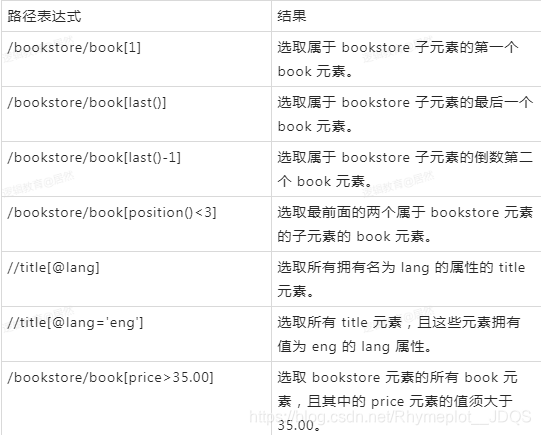
三、lxml模块的使用
1、安装
- 安装pip install lxml / pip install lxml -i https://pypi.douban.com/simple
- 作用:
- 导入:
from lxml import etree - 得到响应结果:网页源码
- etree.HTML (网页源码)—>返回一个element对象
- element对象就可以使用xpath进行导航
代码演示:
- 导入:
from lxml import etree
wb_data = """
<div>
<ul>
<li class="item-0"><a href="link1.html">first item</a></li>
<li class="item-1"><a href="link2.html">second item</a></li>
<li class="item-inactive"><a href="link3.html">third item</a></li>
<li class="item-1"><a href="link4.html">fourth item</a></li>
<li class="item-0"><a href="link5.html">fifth item</a>
</ul>
</div>
"""
# etree.HTML(wb_data)将网页源码转换成element对象
element = etree.HTML(wb_data)
# print(element)
'''
需求:
获取li标签下面的href属性
'''
result1 = element.xpath('//li/a/@href')
print(result1)
for i in result1:
print(i)
'''
需求:
获取li标签下a标签的文本数据
'''
result2 = element.xpath('//li/a/text()')
print(result2)
for j in result2:
print(j)
CSV
一、什么是CSV?
- 是python的一个内置模块
- 概念:CSV (Comma Separated Values)](http://zh.wikipedia.org/zh-cn/逗号分隔值),即逗号分隔值(也称字符分隔值,因为分隔符可以不是逗号),是一种常用的文本格式,用以存储表格数据,包括数字或者字符。很多程序在处理数据时都会碰到csv这种格式的文件。python自带了csv模块,专门用于处理csv文件的读取
二、CSV模块的使用
1、写入csv文件
- 1、 通过创建writer对象,主要用到2个方法。一个是writerow,写入一行。另一个是writerows写入多行
- 2、使用DictWriter 可以使用字典的方式把数据写入进去
2、读取文件
- 1、 通过reader()读取到的每一条数据是一个列表。可以通过下标的方式获取具体某一个值。
- 2、通过DictReader()读取到的数据是一个字典。可以通过Key值(列名)的方式获取数据。
代码演示:
import csv
# 写入数据01:weiterow与writerows
# weiterow
headers = ('name', 'age', 'height')
persons = [('我的梦', '18','178'), ('我的梦', '23','180'), ('我的梦', '25','170')]
with open('persons.csv', 'w', encoding='utf-8') as file_object:
writer1 = csv.writer(file_object)
# writerow()写入一行
writer1.writerow(headers)
for data in persons:
writer1.writerow(data)
# writerows
headers = ('name', 'age', 'height')
persons = [('我的梦', '18','178'), ('我的梦', '23','180'), ('我的梦', '25','170')]
with open('persons1.csv', 'w', encoding='utf-8', newline='') as file_object:
writer1 = csv.writer(file_object)
# writerow()写入一行
writer1.writerow(headers)
writer1.writerows(persons)
# 第二种写入方式
# 注意:字典中的KEY值需要与表头保持一致
headers = ('name', 'age', 'height')
persons = [
{'name': '我的梦', 'age': 18, 'height': 178},
{'name': '125', 'age': 18, 'height': 178},
{'name': '王佳欣', 'age': 24, 'height': 183}
]
with open('persons2.csv', 'w', encoding='utf-8', newline='') as file_object:
writer = csv.DictWriter(file_object, headers)
writer.writeheader()
writer.writerows(persons)
# 读取数据
# 方案一:
with open('persons.csv', 'r', encoding='utf-8') as file_object:
reader = csv.reader(file_object)
for x in reader:
print(x)
# 方案二:
with open('persons2.csv', 'r', encoding='utf-8') as file_object:
reader = csv.DictReader(file_object)
for y in reader:
print(y)
print(y['name'])
xpath与CSV文件练习
爬取豆瓣电影TOP250
- 需求:爬取电影的名字、评分、引言、详情url,保存在csv文件中1-10页 (title、other、star、url、quote)
- 思路
- 01:向目标url发起请求,获取响应对象,拿到网页源码
- 02:通过etree.HTML()函数将网页源码转换成element对象
- 03:通过element对象、xpath导航到我想要获取的数据
- 04:得到title、other、star、url、quote,并放到一个字典中,在保存至字典中
- 05:将列表中的数据保存至CSV文件中
代码实现01:
'''
目标页规律
第一页:https://movie.douban.com/top250?start=0&filter=
第二页:https://movie.douban.com/top250?start=25&filter=
第三页:https://movie.douban.com/top250?start=50&filter=
start = (pag - 1) * 25
目标url需进行10次循环
'''
import requests
import csv
from lxml import etree
import time
list = []
headers = {
'user-agent': 'Mozilla/5.0 (Windows NT 10.0; Win64; x64) AppleWebKit/537.36 (KHTML, like Gecko) Chrome/88.0.4324.104 Safari/537.36'
}
for i in range(0, 250, 25):
url = 'https://movie.douban.com/top250?start=' + str(i) + '&filter='
# 01:向目标url发起请求,获取响应对象,拿到网页源码
response = requests.get(url, headers=headers).content
# 02:通过etree.HTML()函数将网页源码转换成element对象
element = etree.HTML(response)
# 03:通过element对象、xpath导航到我想要获取的数据
result = element.xpath('//ol/li/div[@class="item"]')
# print(len(result1)) # 得到25条电影信息
for html in result:
# # 01:获取电影名字
result_titles = html.xpath('./div[@class="info"]/div[@class="hd"]/a/span[@class="title"]/text()')
# print(result_titles)
# # 02:获取电影别名
result_others = html.xpath('./div[@class="info"]/div[@class="hd"]/a/span[@class="other"]/text()')
# print(result_others)
# # 03:获取电影评分
result_stars = html.xpath('./div[@class="info"]//div[@class="star"]/span[@class="rating_num"]/text()')
# # 04:获取评价
result_qutes = html.xpath('./div[@class="info"]//p[@class="quote"]/span[@class="inq"]/text()')
# # 05:获取电影的url
result_urls = html.xpath('./div[@class="info"]/div[@class="hd"]/a/@href')
# 04:得到title、other、star、url、quote,并放到一个字典中,在保存至字列表中
dict = {}
dict['title'] = result_titles
dict['other'] = result_others
dict['star'] = result_stars
dict['qute'] = result_qutes
dict['url'] = result_urls
print(dict)
list.append(dict)
# # 05:将列表中的数据保存至CSV文件中
header = ['title', 'other', 'star', 'qute', 'url']
with open('TOP电影信息爬取.csv', 'w', encoding='utf-8', newline='') as file_object:
time.sleep(0.5)
writer = csv.DictWriter(file_object, header)
writer.writeheader()
writer.writerows(list)
打印输出结果:

代码实现02:
import requests
import time
from lxml import etree
import csv
'''
目标url规律
URL1 = https://movie.douban.com/top250?start=0&filter=
URL2 = https://movie.douban.com/top250?start=25&filter=
URL3 = https://movie.douban.com/top250?start=50&filter=
规律如下:
pages = (page - 1) * 25
'''
# 1、目标网站
doubanUrl = 'https://movie.douban.com/top250?start={}&filter='
# 2、发起请求获取响应结果
def getSource(url):
headers = {'user-agent': 'Mozilla/5.0 (Macintosh; Intel Mac OS X 11_3_0) AppleWebKit/537.36 (KHTML, like Gecko) Chrome/88.0.4324.192 Safari/537.36'}
time.sleep(0.5)
response = requests.get(url, headers=headers)
response.encoding = 'utf-8'
return response.text
# 3、解析数据(名字、评分、引言、url)
def getEveryItem(source):
html_element = etree.HTML(source)
movieItemList = html_element.xpath('//div[@class="info"]')
# 定义一个空列表,储存电影字典数据
movielist = []
for eachMovie in movieItemList:
# 定义字典,保存字典星系
movieDict = {}
# 1、获取标题(title)
title = eachMovie.xpath('./div[@class="hd"]/a/span[@class="title"][1]/text()')
# 2、获取别名
othertitle = eachMovie.xpath('./div[@class="hd"]/a/span[@class="other"]/text()')
# 3、获取评分
stars = eachMovie.xpath('./div[@class="bd"]/div[@class="star"]/span[@class="rating_num"]/text()')[0]
# 4、获取评语
quote = eachMovie.xpath('./div[@class="bd"]/p[@class="quote"]/span/text()')
# 有些引言没有数据(只要不是空性的,结果为True,反之为空性,结果为false)
if quote:
quote = quote[0]
else:
quote = ''
# 5、获取目标url
url = eachMovie.xpath('./div[@class="hd"]/a/@href')[0]
movieDict['title'] = ''.join(title+othertitle) # 主标题+副标题
movieDict['stars'] = stars # 评分
movieDict['quote'] = quote # 评语
movieDict['url'] = url # 目标url
movielist.append(movieDict)
print(movielist)
return movielist
# 4、保存数据
def writeData(movielist):
with open('douban250.csv','w',encoding='utf-8',newline='') as file_obj:
writer = csv.DictWriter(file_obj,fieldnames=['title','stars','quote','url'])
writer.writeheader()
writer.writerows(movielist)
if __name__ == '__main__':
movielist = []
for i in range(10):
# 获取目标url
pagelink = doubanUrl.format(i * 25)
# 将目标url传入请求函数
source = getSource(pagelink)
# 将请求结果传入解析函数,最终将解析函数的结果传入列表
movielist += getEveryItem(source) # movielist = movielist+getEveryItem(source)含义是将每页获取的结果依次加入列表(逐条写入)
# 将最终写入的列表对象传入写入函数完成csv文件写入
writeData(movielist)
案例总结
- 1、str格式化的运用
str.format()
r''
f''
s1 = '大桥局'
s2 = '大骗局'
r = f'hello {s1},{s2}'
s = 'i like {}' # str.format()
w = s.format(python)
- 2、xpath语法的运用
- ①、生成一个element对象
- ②、通过xpath()进行导航
- 3、csv文件的储存
with open('douban250.csv','w',encoding='utf-8',newline='') as file_obj:
writer = csv.DictWriter(file_obj,fieldnames=['title','stars','quote','url'])
writer.writeheader()
writer.writerows(movielist)
with open('douban.csv','w',encoding='utf-8',newline='') as file_obj:
writer = csv.DictWriter(file_obj,fieldnames=['title','star','quote','url'])
writer.writeheader()
for each in movieList:
writer.writerow(each)
- 4、非空判断
# 非布尔值的判断 只要不是空性的 统统代表是True 反之 空性 [] () {} None 0...
if quote:
quote = quote[0]
else:
quote = ''
BeautifulSoup4
一、BeautifulSoup4简介
1、基本概念
- 概念:Beautiful Soup 是一个可以从HTML或XML文件中提取数据的网页信息提取库
- 简介:在解析网页的时候,每个网页结构都不一样,所以采用最合适的解析技术
2、源码分析
- github下载源码
- 安装:
pip install lxmlpip install bs4
- Beautiful Soup4学习文档链接:Beautiful Soup4文档
二、BeautifulSoup4 快速入门
1、导入
import bs4—一般不用from bs4 import BeautifulSoup
2、Beautiful Soup4解析器的优缺点
- 1、python标准库
- 使用方法:
BeautiSoup(narkup, 'html.parser') - 优势:1、Python的内置标准库 2、执行速度适中 3、文档容错能力强
- 劣势:Python2.7.3 or 3.2.2 之前的版本文档容错能力差
- 使用方法:
- 2、lxmlHTML 解释器
- 使用方法:
BeautiSoup(narkup, 'lxml') - 优势:1、速度快 2、文档容错能力强
- 劣势:需要安装C语言库
- 使用方法:
- 3、lxml XML解释器
- 使用方法:1、
BeautiSoup(narkup, 'xml')2、BeautiSoup('lxml', 'xml') - 优势:1、速度快 2、唯一支持XML的解释器
- 劣势:需要安装C语言库
- 使用方法:1、
- 4、html5lib
- 使用方法:
BeautiSoup(narkup, 'html5lib') - 优势:1、最好的容错性 2、以浏览器的方式解析文档 3、生成HTML5格式的文档
- 劣势:1、速度慢 2、不依赖外部扩展
- 使用方法:
注:推荐使用lxml解析器,因为效率高。
代码演示:
from bs4 import BeautifulSoup
html_doc = """
<html><head><title>The Dormouse's story</title></head>
<body>
<p class="title"><b>The Dormouse's story</b></p>
<p class="story">Once upon a time there were three little sisters; and their names were
<a href="http://example.com/elsie" class="sister" id="link1">Elsie</a>,
<a href="http://example.com/lacie" class="sister" id="link2">Lacie</a> and
<a href="http://example.com/tillie" class="sister" id="link3">Tillie</a>;
and they lived at the bottom of a well.</p>
<p class="story">...</p>
"""
# 第一步:先有一个soup对象(soup是实例对象,BeautifulSoup是类对象)
soup = BeautifulSoup(html_doc, 'lxml')
print(soup.prettify()) # 精简输出(查看复杂结构)
print(soup.title) # 直接通过标签找到数据
print(soup.title.name) # 获取标签的名称
print(soup.title.string) # The Dormouse's story 通过string获得文本数据
print(soup.p) # 通过标签找数据,只找到第一个,以第一个返回
r = soup.find_all('p') # 通过find_All找到所有的满足的数据(p标签的数据)
print(r, len(r))
'''
需求:找到a标签下的href属性(网址)
'''
links = soup.find_all('a')
for link in links:
print(link.get('href'))
三、BeautifulSoup4 的四大对象种类
- 1、ag : 标签
- 2、NavigableString : 可导航的字符串
- 3、BeautifulSoup : soup对象
- 4、Comment : 注释
代码演示:
from bs4 import BeautifulSoup
from bs4.element import NavigableString
html_doc = """
<html><head><title>The Dormouse's story</title></head>
<body>
<p class="title"><b>The Dormouse's story</b></p>
<p class="story">Once upon a time there were three little sisters; and their names were
<a href="http://example.com/elsie" class="sister" id="link1">Elsie</a>,
<a href="http://example.com/lacie" class="sister" id="link2">Lacie</a> and
<a href="http://example.com/tillie" class="sister" id="link3">Tillie</a>;
and they lived at the bottom of a well.</p>
<p class="story">...</p>
"""
# 获得soup对象
soup = BeautifulSoup(html_doc, 'lxml')
'''
tag : 标签
NavigableString : 可导航的字符串
BeautifulSoup : soup对象
Comment : 注释
'''
# 一、tag : 标签
print(type(soup.title)) # 获得<class 'bs4.element.Tag'>
print(type(soup.a)) # 获得<class 'bs4.element.Tag'>
# 二、NavigableString : 可导航的字符串
print(type(soup.title.string)) # 获得<class 'bs4.element.NavigableString'>
# 三、BeautifulSoup : soup对象
print(type(soup)) # 获得<class 'bs4.BeautifulSoup'>
# 四、Comment : 注释
html = '<a><!--大桥局早日倒闭,杭绍台梁断隧塌--></a>'
soup2 = BeautifulSoup(html, 'lxml')
print(type(soup2.string)) # 获得<class 'bs4.element.Comment'>
打印输出结果:
/Volumes/苹果微软公共盘/PycharmProjects/venv/bin/python /Volumes/苹果微软公共盘/PycharmProjects/Python大神班/day-08/03-bs4的四大对象类型.py
<class 'bs4.element.Tag'>
<class 'bs4.element.Tag'>
<class 'bs4.element.NavigableString'>
<class 'bs4.BeautifulSoup'>
<class 'bs4.element.Comment'>
Process finished with exit code 0
四、遍历文档树
- bs里面有三种情况,第一种是遍历、第二种是查找、第三种是修改
1、contents、children、descendants
- cintents:返回一个所有节点的列表
代码演示01:
from bs4 impor4 BeautifulSoup
html_doc = """
<html><head><title>The Dormouse's story</title></head>
<body>
<p class="title"><b>The Dormouse's story</b></p>
<p class="story">Once upon a time there were three little sisters; and their names were
<a href="http://example.com/elsie" class="sister" id="link1">Elsie</a>,
<a href="http://example.com/lacie" class="sister" id="link2">Lacie</a> and
<a href="http://example.com/tillie" class="sister" id="link3">Tillie</a>;
and they lived at the bottom of a well.</p>
<p class="story">...</p>
"""
soup = BeautifulSoup(html_doc, 'lxml')
# contents 返回的是一个所有子节点的列表
head_tag = soup.head
print(head_tag)
res = head_tag.contents
print(res)
- children:返回一个子节点的迭代器
代码演示02:
from bs4 impor4 BeautifulSoup
html_doc = """
<html><head><title>The Dormouse's story</title></head>
<body>
<p class="title"><b>The Dormouse's story</b></p>
<p class="story">Once upon a time there were three little sisters; and their names were
<a href="http://example.com/elsie" class="sister" id="link1">Elsie</a>,
<a href="http://example.com/lacie" class="sister" id="link2">Lacie</a> and
<a href="http://example.com/tillie" class="sister" id="link3">Tillie</a>;
and they lived at the bottom of a well.</p>
<p class="story">...</p>
"""
soup = BeautifulSoup(html_doc, 'lxml')
head_tag = soup.head
print(head_tag.children)# 得到一个迭代器对象,需要遍历才能拿出数据
for i in head_tag.children:
print(i)
- descendants:返回的是一个生成器(特殊的迭代器)。可以遍历出节点的子子孙孙。
代码演示03:
from bs4 impor4 BeautifulSoup
html_doc = """
<html><head><title>The Dormouse's story</title></head>
<body>
<p class="title"><b>The Dormouse's story</b></p>
<p class="story">Once upon a time there were three little sisters; and their names were
<a href="http://example.com/elsie" class="sister" id="link1">Elsie</a>,
<a href="http://example.com/lacie" class="sister" id="link2">Lacie</a> and
<a href="http://example.com/tillie" class="sister" id="link3">Tillie</a>;
and they lived at the bottom of a well.</p>
<p class="story">...</p>
"""
soup = BeautifulSoup(html_doc, 'lxml')
head_tag = soup.html
for i in head_tag.descendants:
print('-'*80)
print(i)
2、string、strings、stripped_strings
- string:获取标签里面的内容
代码演示01:
from bs4 import BeautifulSoup
html_doc = """
<html><head><title>The Dormouse's story</title></head>
<body>
<p class="title"><b>The Dormouse's story</b></p>
<p class="story">Once upon a time there were three little sisters; and their names were
<a href="http://example.com/elsie" class="sister" id="link1">Elsie</a>,
<a href="http://example.com/lacie" class="sister" id="link2">Lacie</a> and
<a href="http://example.com/tillie" class="sister" id="link3">Tillie</a>;
and they lived at the bottom of a well.</p>
<p class="story">...</p>
"""
soup = BeautifulSoup(html_doc, 'lxml')
title_tag = soup.title
print(title_tag.string)
- strings:返回一个生成器对象,用来获取多个标签的内容
代码演示02:
from bs4 import BeautifulSoup
html_doc = """
<html><head><title>The Dormouse's story</title></head>
<body>
<p class="title"><b>The Dormouse's story</b></p>
<p class="story">Once upon a time there were three little sisters; and their names were
<a href="http://example.com/elsie" class="sister" id="link1">Elsie</a>,
<a href="http://example.com/lacie" class="sister" id="link2">Lacie</a> and
<a href="http://example.com/tillie" class="sister" id="link3">Tillie</a>;
and they lived at the bottom of a well.</p>
<p class="story">...</p>
"""
soup = BeautifulSoup(html_doc, 'lxml')
res = soup.html.strings
for i in res:
print(i)
- stripped_strings:stripped_strings和strings基本一致,但是它可以把多余的空格去掉
代码演示03:
from bs4 import BeautifulSoup
html_doc = """
<html><head><title>The Dormouse's story</title></head>
<body>
<p class="title"><b>The Dormouse's story</b></p>
<p class="story">Once upon a time there were three little sisters; and their names were
<a href="http://example.com/elsie" class="sister" id="link1">Elsie</a>,
<a href="http://example.com/lacie" class="sister" id="link2">Lacie</a> and
<a href="http://example.com/tillie" class="sister" id="link3">Tillie</a>;
and they lived at the bottom of a well.</p>
<p class="story">...</p>
"""
soup = BeautifulSoup(html_doc, 'lxml')
res = soup.html.stripped_strings
for i in res:
print(i)
3、parent和parents
- parent:直接获取父节点
代码演示01:
from bs4 import BeautifulSoup
html_doc = """
<html><head><title>The Dormouse's story</title></head>
<body>
<p class="title"><b>The Dormouse's story</b></p>
<p class="story">Once upon a time there were three little sisters; and their names were
<a href="http://example.com/elsie" class="sister" id="link1">Elsie</a>,
<a href="http://example.com/lacie" class="sister" id="link2">Lacie</a> and
<a href="http://example.com/tillie" class="sister" id="link3">Tillie</a>;
and they lived at the bottom of a well.</p>
<p class="story">...</p>
"""
soup = BeautifulSoup(html_doc, 'lxml')
title_tag = soup.title
print(title_tag.parent)
print(soup.html.parent)
- parents:获取所有的父节点
代码演示02:
x from bs4 import BeautifulSoup
html_doc = """
<html><head><title>The Dormouse's story</title></head>
<body>
<p class="title"><b>The Dormouse's story</b></p>
<p class="story">Once upon a time there were three little sisters; and their names were
<a href="http://example.com/elsie" class="sister" id="link1">Elsie</a>,
<a href="http://example.com/lacie" class="sister" id="link2">Lacie</a> and
<a href="http://example.com/tillie" class="sister" id="link3">Tillie</a>;
and they lived at the bottom of a well.</p>
<p class="story">...</p>
"""
soup = BeautifulSoup(html_doc, 'lxml')
a_tag = soup.a
for i in a_tag.parents:
print(i)
4、遍历兄弟节点
- next_sibling:下一个兄弟结点
代码演示01:
from bs4 import BeautifulSoup
html_data = '<a><b>bbbb</b><c>cccc</c></a>'
soup = BeautifulSoup(html_data, 'lxml')
# print(soup.prettify())
b_tag = soup.b
print(b_tag.next_sibling)片
- previous_sibling 上一个兄弟结点
代码演示02:
from bs4 import BeautifulSoup
html_data = '<a><b>bbbb</b><c>cccc</c></a>'
soup = BeautifulSoup(html_data, 'lxml')
c_tag = soup.c
print(c_tag.previous_sibling )
- previous_siblings上一个所有兄弟结点
代码演示03:
from bs4 import BeautifulSoup
html_data = '<a><b>bbbb</b><c>cccc</c></a>'
soup = BeautifulSoup(html_data, 'lxml')
b_tag = soup.b
res = b_tag.previous_siblings
for i in res:
print(i)
五、find()与find_all()方法
1、过滤器
- 字符串过滤器
代码演示01:
from bs4 import BeautifulSoup
html_doc = """
<html><head><title>The Dormouse's story</title></head>
<body>
<p class="title"><b>The Dormouse's story</b></p>
<p class="story">Once upon a time there were three little sisters; and their names were
<a href="http://example.com/elsie" class="sister" id="link1">Elsie</a>,
<a href="http://example.com/lacie" class="sister" id="link2">Lacie</a> and
<a href="http://example.com/tillie" class="sister" id="link3">Tillie</a>;
and they lived at the bottom of a well.</p>
<p class="story">...</p>
"""
soup = BeautifulSoup(html_doc, 'lxml')
# 字符串过滤器
a_tag = soup.find('a') # 参数"a"代表字符串过滤器
print(a_tag)
a_tags = soup.find_all('a')
for i in a_tags:
print(i)
- 列表过滤器
代码演示02:
from bs4 import BeautifulSoup
html_doc = """
<html><head><title>The Dormouse's story</title></head>
<body>
<p class="title"><b>The Dormouse's story</b></p>
<p class="story">Once upon a time there were three little sisters; and their names were
<a href="http://example.com/elsie" class="sister" id="link1">Elsie</a>,
<a href="http://example.com/lacie" class="sister" id="link2">Lacie</a> and
<a href="http://example.com/tillie" class="sister" id="link3">Tillie</a>;
and they lived at the bottom of a well.</p>
<p class="story">...</p>
"""
soup = BeautifulSoup(html_doc, 'lxml')
print(soup.find_all(['p','a']))
print(soup.find_all(['title','b'])) # ['title','b']为列表过滤器
2、find_all()方法
- 简介
- fand_all()方法以列表形式返回所有搜索到的标签数据
- find()方法返回搜索到的第一条数据
- fiand_all()方法的参数
def find_all(self, name=None, attrs={}, recursive=True, text=None,
limit=None, **kwargs):
- 参数含义
- name : tag名称
- attr : 标签的属性
- recursive : 是否递归搜索
- text : 文本内容
- limli : 限制返回条数
- kwargs : 关键字参数
代码演示01:
html = """
<table class="tablelist" cellpadding="0" cellspacing="0">
<tbody>
<tr class="h">
<td class="l" width="374">职位名称</td>
<td>职位类别</td>
<td>人数</td>
<td>地点</td>
<td>发布时间</td>
</tr>
<tr class="even">
<td class="l square"><a target="_blank" href="position_detail.php?id=33824&keywords=python&tid=87&lid=2218">22989-金融云区块链高级研发工程师(深圳)</a></td>
<td>技术类</td>
<td>1</td>
<td>深圳</td>
<td>2017-11-25</td>
</tr>
<tr class="odd">
<td class="l square"><a target="_blank" href="position_detail.php?id=29938&keywords=python&tid=87&lid=2218">22989-金融云高级后台开发</a></td>
<td>技术类</td>
<td>2</td>
<td>深圳</td>
<td>2017-11-25</td>
</tr>
<tr class="even">
<td class="l square"><a target="_blank" href="position_detail.php?id=31236&keywords=python&tid=87&lid=2218">SNG16-腾讯音乐运营开发工程师(深圳)</a></td>
<td>技术类</td>
<td>2</td>
<td>深圳</td>
<td>2017-11-25</td>
</tr>
<tr class="odd">
<td class="l square"><a target="_blank" href="position_detail.php?id=31235&keywords=python&tid=87&lid=2218">SNG16-腾讯音乐业务运维工程师(深圳)</a></td>
<td>技术类</td>
<td>1</td>
<td>深圳</td>
<td>2017-11-25</td>
</tr>
<tr class="even">
<td class="l square"><a target="_blank" href="position_detail.php?id=34531&keywords=python&tid=87&lid=2218">TEG03-高级研发工程师(深圳)</a></td>
<td>技术类</td>
<td>1</td>
<td>深圳</td>
<td>2017-11-24</td>
</tr>
<tr class="odd">
<td class="l square"><a target="_blank" href="position_detail.php?id=34532&keywords=python&tid=87&lid=2218">TEG03-高级图像算法研发工程师(深圳)</a></td>
<td>技术类</td>
<td>1</td>
<td>深圳</td>
<td>2017-11-24</td>
</tr>
<tr class="even">
<td class="l square"><a target="_blank" href="position_detail.php?id=31648&keywords=python&tid=87&lid=2218">TEG11-高级AI开发工程师(深圳)</a></td>
<td>技术类</td>
<td>4</td>
<td>深圳</td>
<td>2017-11-24</td>
</tr>
<tr class="odd">
<td class="l square"><a target="_blank" href="position_detail.php?id=32218&keywords=python&tid=87&lid=2218">15851-后台开发工程师</a></td>
<td>技术类</td>
<td>1</td>
<td>深圳</td>
<td>2017-11-24</td>
</tr>
<tr class="even">
<td class="l square"><a target="_blank" href="position_detail.php?id=32217&keywords=python&tid=87&lid=2218">15851-后台开发工程师</a></td>
<td>技术类</td>
<td>1</td>
<td>深圳</td>
<td>2017-11-24</td>
</tr>
<tr class="odd">
<td class="l square"><a id="test" class="test" target='_blank' href="position_detail.php?id=34511&keywords=python&tid=87&lid=2218">SNG11-高级业务运维工程师(深圳)</a></td>
<td>技术类</td>
<td>1</td>
<td>深圳</td>
<td>2017-11-24</td>
</tr>
</tbody>
</table>
"""
soup = BeautifulSoup(html, 'lxml')
# 1、获取所有tr标签
print(soup.tr)
print(soup.find('tr'))
print(soup.find_all('tr'))
# 2、获取第二个突然标签
tr = soup.find_all('tr')[1]
print(tr)
# limit参数:限制返回条数
tr = soup.find_all('tr', limit=2)[1]
print(tr)
# 3、获取所有class等于even的tr标签(class是python中的关键字,不允许直接写出,需要加_装饰一下)
trs = soup.find_all('tr', class_='even')
for tr in trs:
print(tr)
print('-'*80)
# 4、将所有id='text'和class='text'的a标签提取出来
r = soup.find_all('a', id='test', class_='test')
for a in r:
print(a)
# 5、获取所有a标签的href属性
a_tag = soup.find_all('a')
for a in a_tag:
# 1
href = a['href']
print(href)
2
href = a.get('href')
print(href)
# 6、获取所有的职位信息(需要文本)
trs = soup.find_all('tr')[1:]# 找到所有的tr标签柄过滤第一个tr
for tr in trs:
tds = tr.find_all('td')# 找tr标签里所有的td标签
job_name = tds[0].string # 将符合条件的td标签取出来
print(job_name)
六、select()方法
- 根据类名来进行查找
通过类名来进行查找 .class(这个class表示的是类的值)
print(soup.select('.sister'))
- 根据id来进行查找
通过id进行查找 #id(id表示的是这个值)
print(soup.select('#link1'))
代码演示01:
html = """
<table class="tablelist" cellpadding="0" cellspacing="0">
<tbody>
<tr class="h">
<td class="l" width="374">职位名称</td>
<td>职位类别</td>
<td>人数</td>
<td>地点</td>
<td>发布时间</td>
</tr>
<tr class="even">
<td class="l square"><a target="_blank" href="position_detail.php?id=33824&keywords=python&tid=87&lid=2218">22989-金融云区块链高级研发工程师(深圳)</a></td>
<td>技术类</td>
<td>1</td>
<td>深圳</td>
<td>2017-11-25</td>
</tr>
<tr class="odd">
<td class="l square"><a target="_blank" href="position_detail.php?id=29938&keywords=python&tid=87&lid=2218">22989-金融云高级后台开发</a></td>
<td>技术类</td>
<td>2</td>
<td>深圳</td>
<td>2017-11-25</td>
</tr>
<tr class="even">
<td class="l square"><a target="_blank" href="position_detail.php?id=31236&keywords=python&tid=87&lid=2218">SNG16-腾讯音乐运营开发工程师(深圳)</a></td>
<td>技术类</td>
<td>2</td>
<td>深圳</td>
<td>2017-11-25</td>
</tr>
<tr class="odd">
<td class="l square"><a target="_blank" href="position_detail.php?id=31235&keywords=python&tid=87&lid=2218">SNG16-腾讯音乐业务运维工程师(深圳)</a></td>
<td>技术类</td>
<td>1</td>
<td>深圳</td>
<td>2017-11-25</td>
</tr>
<tr class="even">
<td class="l square"><a target="_blank" href="position_detail.php?id=34531&keywords=python&tid=87&lid=2218">TEG03-高级研发工程师(深圳)</a></td>
<td>技术类</td>
<td>1</td>
<td>深圳</td>
<td>2017-11-24</td>
</tr>
<tr class="odd">
<td class="l square"><a target="_blank" href="position_detail.php?id=34532&keywords=python&tid=87&lid=2218">TEG03-高级图像算法研发工程师(深圳)</a></td>
<td>技术类</td>
<td>1</td>
<td>深圳</td>
<td>2017-11-24</td>
</tr>
<tr class="even">
<td class="l square"><a target="_blank" href="position_detail.php?id=31648&keywords=python&tid=87&lid=2218">TEG11-高级AI开发工程师(深圳)</a></td>
<td>技术类</td>
<td>4</td>
<td>深圳</td>
<td>2017-11-24</td>
</tr>
<tr class="odd">
<td class="l square"><a target="_blank" href="position_detail.php?id=32218&keywords=python&tid=87&lid=2218">15851-后台开发工程师</a></td>
<td>技术类</td>
<td>1</td>
<td>深圳</td>
<td>2017-11-24</td>
</tr>
<tr class="even">
<td class="l square"><a target="_blank" href="position_detail.php?id=32217&keywords=python&tid=87&lid=2218">15851-后台开发工程师</a></td>
<td>技术类</td>
<td>1</td>
<td>深圳</td>
<td>2017-11-24</td>
</tr>
<tr class="odd">
<td class="l square"><a id="test" class="test" target='_blank' href="position_detail.php?id=34511&keywords=python&tid=87&lid=2218">SNG11-高级业务运维工程师(深圳)</a></td>
<td>技术类</td>
<td>1</td>
<td>深圳</td>
<td>2017-11-24</td>
</tr>
</tbody>
</table>
"""
soup = BeautifulSoup(html, 'lxml')
# 1、获取tr
trs = soup.select('tr')
print(trs)
# 2、获取第二个tr标签
tr = soup.select('tr')[1]
print(tr)
# 3、获取所有class=evenbiaoq
trs = soup.select('.even')
print(trs)
trs = soup.select('tr[class="even"]')
print(trs)
# 4、获取所有a标签href属性
a_tags = soup.select('a')
for a in a_tags:
href = a['href']
print(href)
# 5、获取所有的职位信息
trs = soup.select('tr')[1:]
for tr in trs:
info = list(tr.stripped_strings)[0]
print(info)
七、修改文档树
- 修改tag的名称和属性
代码演示01:
from bs4 import BeautifulSoup
html_doc = """
<html><head><title>The Dormouse's story</title></head>
<body>
<p class="title"><b>The Dormouse's story</b></p>
<p class="story">Once upon a time there were three little sisters; and their names were
<a href="http://example.com/elsie" class="sister" id="link1">Elsie</a>,
<a href="http://example.com/lacie" class="sister" id="link2">Lacie</a> and
<a href="http://example.com/tillie" class="sister" id="link3">Tillie</a>;
and they lived at the bottom of a well.</p>
<p class="story">...</p>
"""
soup = BeautifulSoup(html_doc, 'lxml')
# 修改tag的名称和属性
tag_p = soup.p
print(tag_p)
tag_p['class'] = 'content' # 修改属性
tag_p.name = 'w' # 修改名称
print(tag_p)
- 修改string 属性赋值,就相当于用当前的内容替代了原来的内容
代码演示02:
from bs4 import BeautifulSoup
html_doc = """
<html><head><title>The Dormouse's story</title></head>
<body>
<p class="title"><b>The Dormouse's story</b></p>
<p class="story">Once upon a time there were three little sisters; and their names were
<a href="http://example.com/elsie" class="sister" id="link1">Elsie</a>,
<a href="http://example.com/lacie" class="sister" id="link2">Lacie</a> and
<a href="http://example.com/tillie" class="sister" id="link3">Tillie</a>;
and they lived at the bottom of a well.</p>
<p class="story">...</p>
"""
soup = BeautifulSoup(html_doc, 'lxml')
# 修改string 属性赋值,就相当于用当前的内容替代了原来的内容
tag_p = soup.p
print(tag_p.string)
tag_p.string = 'you need python'
print(tag_p)
- append() 像tag中添加内容,就好像Python的列表的 .append() 方法
代码演示03:
from bs4 import BeautifulSoup
html_doc = """
<html><head><title>The Dormouse's story</title></head>
<body>
<p class="title"><b>The Dormouse's story</b></p>
<p class="story">Once upon a time there were three little sisters; and their names were
<a href="http://example.com/elsie" class="sister" id="link1">Elsie</a>,
<a href="http://example.com/lacie" class="sister" id="link2">Lacie</a> and
<a href="http://example.com/tillie" class="sister" id="link3">Tillie</a>;
and they lived at the bottom of a well.</p>
<p class="story">...</p>
"""
soup = BeautifulSoup(html_doc, 'lxml')
# append() 像tag中添加内容,就好像Python的列表的 .append() 方法
tag_p = soup.p
print(tag_p)
tag_p.append('123')
print(tag_p)
- decompose() 修改删除段落,对于一些没有必要的文章段落我们可以给他删除掉
代码演示04:
from bs4 import BeautifulSoup
html_doc = """
<html><head><title>The Dormouse's story</title></head>
<body>
<p class="title"><b>The Dormouse's story</b></p>
<p class="story">Once upon a time there were three little sisters; and their names were
<a href="http://example.com/elsie" class="sister" id="link1">Elsie</a>,
<a href="http://example.com/lacie" class="sister" id="link2">Lacie</a> and
<a href="http://example.com/tillie" class="sister" id="link3">Tillie</a>;
and they lived at the bottom of a well.</p>
<p class="story">...</p>
"""
soup = BeautifulSoup(html_doc, 'lxml')
# decompose() 修改删除段落,对于一些没有必要的文章段落我们可以给他删除掉
r = soup.find(class_ = 'title')
# print(r)
r.decompose()
print(soup)
BeautifulSoup4 案例实践
'''
需求:
爬取全国所有的城市(包括直辖市的区)的名称、温度。并保存在CSV文件中。
'''
代码实践:
import requests
import csv
from bs4 import BeautifulSoup
titles = ('city', 'temp')
def parse_page(url):
headers = {
'User-Agent': 'Mozilla/5.0 (Windows NT 10.0; WOW64) AppleWebKit/537.36 (KHTML, like Gecko) Chrome/88.0.4324.182 Safari/537.36'}
# 发起请求,获取相应响应数据
response = requests.get(url, headers=headers)
# print(response.content.decode('utf-8'))
text = response.content.decode('utf-8')
# 解析网页数据:寻找整页的div = div ="conMidtab"标签
# html5lib可以解决标签错乱
soup = BeautifulSoup(text, 'html5lib')
conMidtab = soup.find('div', class_='conMidtab')
# print(conMidtab)
# 接下来找到每一个直辖市或者每一个省会的标签
tables = conMidtab.find_all('table')
# 定义列表保存数据
lst = []
for table in tables:
# 找table标签里的tr标签(注:将前两个过滤)
trs = table.find_all('tr')[2:]
# enumerate()方法返回两个值,一个是值,另一个是下标索引
for index,tr in enumerate(trs):
# tr标签当前页面所有城市的基本信息
# tr标签里面去找td标签(第0个td是城市的名称,倒数第二个是温度信息)
tds = tr.find_all('td')
'''
当我们这样取成熟名称数据的时候city_td = tds[0],除了省份的第一个城市名称不对,其余的都是正确的。解决办法:找到有问题的tr标签,第0个tr标签有问题
'''
city_td = tds[0] #得到城市标签
if index == 0: # 当下标索引值为0时,对第二个td标签进行取值
city_td = tds[1]
info = {}
city = list(city_td.stripped_strings)[0] #得到城市
temp_td = tds[-2] # 得到温度标签
temp = list(temp_td.stripped_strings)[0]
info['city'] = city
info['temp'] = temp
lst.append(info)
print('city:', city,'temp:', temp)
return lst
def writerDate(lst):
with open('weather.csv', 'w', encoding='utf-8', newline='') as file_obj:
writer = csv.DictWriter(file_obj, titles)
writer.writeheader()
writer.writerows(lst)
def main():
lst = []
# 先去请求华北地区的数据,后请求其他
urls = ['hb', 'db', 'hd', 'hz', 'hn', 'xb', 'xn', 'gat']
for url in urls:
country_url = 'http://www.weather.com.cn/textFC/' + str(url) + '.shtml'
lst += parse_page(country_url)
writerDate(lst)
if __name__ == '__main__':
main()
分析:
解决方案:通过bs4进行解析网页
分析:
1、每一页代表一个区域的信息,所以先确定一个区别,然后动态的替换url
2、分析页面结构
- 1、寻找整页的div = div ="conMidtab"标签
- 2、接下来找到每一个直辖市或者每一个省会的标签
- 3、找table标签里的tr标签(注:将前两个过滤)
- 4、tr标签里面去找td标签(第0个td是城市的名称,倒数第二个是温度信息)
总结:
1、bs4的特点:通过find()或者时find_all()方法去找标签的内容
2、如何过滤不需要的标签或数据(基础的支持点)
3、enumerate()方法的含义及其用法:enumerate()方法返回两个值,一个是值,另一个是下标索引
4、在数据不正确的情况下,如何的去分析判断
city_td = tds[0] #得到城市标签
if index == 0: # 当下标索引值为0时,对第二个td标签进行取值
city_td = tds[1]
5、不同的url页面的处理:通过把URL放在列表中进行去遍历
6、页面标签不全或者是错乱,bs4提供了一个更加强大的解析器(html5lib)
7、CSV文件的应用








 本文介绍了Python中的正则表达式,包括其概念、应用场景、在Python中的支持以及re模块的常用方法。接着讲解了XPath的基本概念、节点关系、应用以及lxml模块的使用。最后探讨了CSV文件的读写操作,并结合BeautifulSoup4进行了网页信息提取和数据存储的案例实践。
本文介绍了Python中的正则表达式,包括其概念、应用场景、在Python中的支持以及re模块的常用方法。接着讲解了XPath的基本概念、节点关系、应用以及lxml模块的使用。最后探讨了CSV文件的读写操作,并结合BeautifulSoup4进行了网页信息提取和数据存储的案例实践。

















 被折叠的 条评论
为什么被折叠?
被折叠的 条评论
为什么被折叠?








